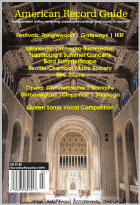Texte paru dans: / Appeared in: |
|
|
Outil de traduction ~ (Très approximatif) |
|
|
Reviewer: John
W. Barker
Now here’s a really obscure
composer for us all. You are not likely to find other recordings of his
music. He is not even granted an entry in New Grove. Still, Giovanni Stefano
Carbonelli (1694-1773) deserves a nod. He was one of the many Italian violin
virtuosos who left his homeland to find his talents in demand elsewhere. He
settled in London and became one of the most important players in Handel’s
company and in other theater groups. He converted to Anglicanism, married
into English social life, was a valued teacher, and developed an extremely
profitable sideline as a merchant of fine wines. He seems to have left only a small legacy of his own compositions, and the most important is a set of 12 sonatas for violin and continuo, published elegantly in 1729 under the title of “Chamber Sonatas”. There were so many Italian violinists who grew up under the shadow of Corelli. Carbonelli seems to have been one who learned from the master but developed some individuality of his own. Unlike Corelli in his Op. 5, where sonatas designated as “chamber” (rather than church) works consisted of dance movements, Carbonelli only rarely included dances (a Giga here and there). He normally constructed his sonatas in four movements. Above all, while he included a good deal of appropriately showy writing, he displayed a flair for tunefulness. He constantly developed longlimbed melodies that can be quite appealing. A good example of his balancing these two elements is in the final movement of No. 6 here, a theme with variations that may have been inspired by Corelli’s wonderful La Follia extravaganza (Op. 5:12). Carbonelli launches into it with great charm but gradually builds into an ostentatious display of virtuosity. That last characteristic is particularly appropriate for the talents of violinist Cicic.
(His name cannot be properly
spelled here without its diacritical marks.) He plays with a full-blooded
sound and is fully up to virtuosic demands. But he is also responsive to
subtleties and melodic flow, with a fine range of dynamic nuances. If
Carbonelli’s music is to have a convincing champion at all, this player is
it. He is supported by three other instrumentalists who play expertly on
bass viol, theorbo, archlute, and baroque guitar, as well as on harpsichord
and organ—nicely varying their colors.
This release offers, of
course, only the first half of the 1729 publication. I do hope that we are
soon to have the other half from these same performers.
| |
|
|
|
|
Cliquez l'un ou l'autre
bouton pour découvrir bien d'autres critiques de CD |
|




